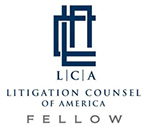A. Introduction
There has been a huge shift in the modern business world to conduct transactions and communications electronically. Most people are probably unaware of the price of first-class postage. Federal courts use e-filing almost exclusively throughout the country; there is a push for state courts to adopt e-filing, as well; and discovery must generally be accompanied with an electronic format. Trial Rule 34 of both the state and federal rules define Document. It includes, among other things, “electronically stored information” (“ESI”). But what is ESI and how does a litigator know what to produce and what to request?
Electronic discovery (“e-discovery”) refers to the collection and production of ESI. The Federal Rules of Civil Procedure were amended in 2006 to account for ESI and e-discovery. This article’s aim is to clarify ESI issues as they relate to spoliation and to provide effective tools for managing e-discovery at the onset of litigation and even before litigation is reasonably foreseeable.
B. Spoliation Defined
Under Indiana law, spoliation of evidence consists of “the intentional destruction, mutilation, alteration or concealment of evidence, usually a document.” Loomis v. Ameritech Corp., 764 N.E.2d 658, 662 (Ind. Ct. App. 2002) (quoting Calhoon v. Cummings, 734 N.E.2d 535, 545 (Ind. 2000)). A party claiming spoliation must demonstrate that there was an obligation to preserve the evidence, the evidence was destroyed with a culpable mind, and that the evidence was relevant. See, Gutman v. Klein, 2008 U.S. Dist. LEXIS 92398, *22 (E.D.N.Y. 2008). Though there is an intentional aspect to spoliation, it is highly advisable to take all reasonable steps to ensure that counsel and all clients understand that there can be significant and draconian sanctions for spoliation of evidence as well as a negative inference under case law and the rules of evidence. Further, what constitutes “intent” and what rises to the level of an “obligation” may be more than a little hazy in interpretation and can vary widely from court to court.
C. The Duty to Preserve Evidence
“The duty to preserve evidence includes any relevant evidence over which the non-preserving entity had control and reasonably knew or could reasonably foresee was material to a potential legal action.” In re Kmart Corp., 371 B.R. 823, 842 (Bkrtcy. N.D. 2007). In order to fulfill this duty, “[o]nce a party reasonably anticipates litigation, it must suspend its routine retention/destruction policy and put in place a ‘litigation hold’ to ensure the preservation of relevant documents.” Sampson v. City of Cambridge, 251 F.R.D. 172, 179 (D. Md. 2008). Although this quote from Sampson refers specifically to halting a routine practice of destroying documents, it demonstrates more broadly the duty to prevent destruction of a piece of relevant evidence and to ensure its protection. What is deemed relevant early on in litigation can be more than vague. Id. But this duty to preserve seems not to be laid just at the doorstep of the client. What are the obligations of counsel to send out a “litigation hold” letter and notify the client that litigation is reasonably foreseeable?
Stated differently, a party is not obliged to preserve evidence until it is notified of the relevance of the evidence: “a party’s duty to preserve specific types of documents does not arise unless the party controlling the documents has notice of those documents’ relevance.” Id. But from where does this notification come? While filing a complaint surely triggers this duty, “the obligation to preserve evidence may arise prior to the filing of a complaint where a party is on notice that litigation is likely to commence.” Id. (citing Cohn v. Taco Bell Corp., 1995 WL 519968 at 5 (N.D. Ill. 1995)). In fact, this duty covers the period where a party should have known that evidence would be relevant to future litigation and covers documents that could reasonably be calculated to lead to the discovery of admissible evidence. See Zublulake v. UBS Warburg, LLC, 220 F.R.D. 212 (S.D.N.Y. Oct. 22, 2003). Further, the duty extends to all employees who are likely to have relevant information. Id. Moreover, the documents that the client is to protect may be vast and relate back for many years. As retention technology increases, there may be a push by courts to require a retrievable backup of documents relating to anything that may be even tangentially related to possible litigation. One can soon see that the definition of what constitutes an invocation of a duty to preserve, spoliation, and retention is becoming increasingly nebulous.
D. Consequences of Spoliation
1. Sanctions
Failure to preserve relevant documents may lead to a wide variety of sanctions. Sanctions in the e-discovery world are not uncommon and conduct that hinders the access to relevant information is sanctionable. In Qualcomm Inc. v. Broadcom Corp., a patent infringement case, the court sanctioned a litigant more than $8.5 million for attorneys’ fees, litigation costs, and pre- and post-judgment interest for destroying thousands of documents and e-mails. 2007 U.S. Dist. LEXIS 82965, *39 (S.D. Cal. 2007).
Federal Rule of Civil Procedure (“FRCP”) 37(e) provides a safe harbor period for parties that fail to preserve relevant e-discovery due to normal business operations. The normal business operations must be routine and done in good faith, and if so, the court may not impose sanctions. Also, a court, before sanctions are granted, must determine that the party claiming spoliation was prejudiced. See Mosaid Technologies, Inc. v. Samsung Electronics Co., Ltd., 2004 U.S. Dist. LEXIS 23596 (D.N.J. 2004). However, the decision in Mosaid and those like it seem to weaken the impact of this safe harbor provision where, as mentioned above, courts move toward requiring litigants to specifically define and formulate an e-discovery plan. With a plan in place, there appears to be little that FRCP 37(e) can do to mitigate the effect of a spoliation finding.
2. Adverse Inference
If spoliation is proved, a jury can infer that the “missing evidence was unfavorable.” Glotzbach v. Froman, 854 N.E.2d 337, 338 (Ind. 2006). To receive an adverse inference instruction, it must be established that “the unavailable evidence is relevant to [the] claims or defenses” of the moving party. Gutman, 2008 U.S. Dist. LEXIS 92398 at *40. The evidence must be sufficient and relevant as to meet the standards as prescribed by Federal Rules of Evidence 401. Id.
3. Entry of Judgment
A court may even enter full or partial judgment against a party found to have committed spoliation. However, this harsh sanction of dismissal is “limited to cases involving willfulness [or] bath faith” and should be used only “in extreme circumstances.” Id. For example, in Gutman, the court ordered a default judgment, attorneys’ fees, and costs because the nonmoving party obliterated laptop files that could have been critical to the moving party. Id. While Gutman is an extreme case, it solidifies the power of a court to dismiss an action if the spoliation is egregious enough.
4. Attorneys’ Fees and Costs
As alluded to above, a court can order attorneys’ fees and costs to remedy delay and waste due to disputes regarding e-discovery and spoliation. Id. The fees shall be reasonable and made pursuant to FRCP 37. Id.
E. Avoiding Spoliation
1. Litigation Hold Letter
A litigation hold is a suspension in a company’s usual document retention and/or destruction polices because of an imminent litigation. Litigation holds can either be self-imposed or court-imposed through a preservation order (preservation orders will be discussed separately below). Litigation holds are an effective tool to ensure that all relevant data and documents are available for discovery and not destroyed.
Litigation hold letters can be sent from the opposing attorney, sent internally, or come from counsel who usually represents a client in a particular matter to which the letter may relate. The letter’s aim is to put parties on “notice with respect to [their] duties to avoid spoliation.” Stone v. Lockheed Martin Corp., 2009 U.S. Dist. LEXIS 12105, *4 (D. Colo. 2009). These letters should be sent well before litigation and even before discovery has commenced. Id. at *5. However, this last mandate as to when the letter ought to be sent has its obvious complications. Determinations as to when litigation is “imminent,” the scope and breadth of the hold letter, and anticipation (before ever seeing formal allegations in a complaint) of what documents may be relevant can easily vary from one reasonable person to another.
In addition to instructing that documents be retained, litigation hold letters should identify possible witnesses and materials and then set out a plan for preserving the relevant documentation. It is also advisable to guarantee that relevant documents can be easily retrieved. It is imperative that attorneys discuss these litigation hold letters and the duty to preserve and retain documents with their clients on a regular basis. The consequences of a failure to heed should also be made known to the client. However, diligent counsel must remain cognizant that a litigation hold letter could very well be admissible. See Rambus, Inc. v. Infineon Techs. AG, 220 F.R.D. 264 (E.D. Va. 2004).
Each institutional client should have an organization-wide approach to responding to and requesting e-discovery. These preservation policies should maximize compliance with potential litigation in order to avoid spoliation claims. Again, it is essential that the policies seek to convey the importance of document retention and also the potential consequences of improper destruction.
In any event, issuing a litigation hold is only the beginning. Counsel should oversee the hold process and ensure that the retention and production is on schedule. “It is not sufficient to notify all employees of a litigation hold and expect that the party will then retain and produce all relevant information. Counsel must take affirmative steps to monitor compliance so that all sources of discoverable information are identified and searched.” Zubulake v. UBS Warburg LLC, 229 F.R.D. 422, 432 (S.D.N.Y. 2004).
2. Preservation Order
If one has concerns that an opposing party may destroy documents relevant to litigation, sending a litigation hold letter to opposing counsel may not be enough protection. Instead, counsel may want to consider a motion for preservation made pursuant to FRCP 26(f). A preservation order “protects the producing party by defining clearly the extent of its obligations.” Treppel, 233 F.R.D. at 369.
However, preservation orders are “burdensome and expensive and in the absence of clear need should not be lightly entered.” Gregg v. Local 305 IBEW, 2008 U.S. Dist. LEXIS 99075, *2 (N.D. Ind. 2008) (quoting Valdez v. Town of Brookhaven, 2007 U.S. Dist. 48638, at *2 (E.D.N.Y. 2007)). Courts seem more willing to issue a preservation order when there has been a history of destruction and significant, imminent threat of loss of documents. See Capricorn Power Co. v. Siemens Westinghouse Power Corp., 220 F.R.D. 429 (W.D. Pa. 2004). In addition, a preservation order will more likely be issued if counsel can demonstrate that having the documents is substantially more valuable to the presentation of the client’s case than any benefit that may be derived from an inference of negativity the fact finder may give to such destruction and/or spoliation. That is, counsel should seek to “establish that unique and critical evidence will be destroyed” and that a preservation order would not be “unduly burdensome” to the nonmoving party. Treppel, 233 F.R.D. at 371-72.
3. E-Discovery Stipulation
The 2006 Amendments to the FRCP frequently mention e-discovery and ESI. By way of example, FRCP 16 requires that parties meet and discuss e-discovery and ESI before the pretrial conference. FRCP 26(a)(1)(ii) requires a description by category and location of ESI as part of the parties’ respective initial disclosures. FRCP 26(f)(3)(C) mandates that a discovery plan contain a statement that the parties have discussed the disclosure and production of e-discovery and ESI. Some local rules or specific court case management plans go farther and require that an e-discovery stipulation be entered into among the parties. Moreover, FRCP 34 defines what constitutes a document, which specifically includes ESI.
It is highly advisable that, regardless of mandate, the parties enter into a formal e-discovery and ESI stipulation. The stipulation should be fairly broad and should be incorporated into litigation hold letters. The ESI and e-discovery stipulation should additionally be referenced in any document request made pursuant to FRCP 34.
4. Internet Archives
Lastly, if a company does not have the capabilities of extensive document retention, there are other methods available to find archived documents. For example, the court in Telewizja Polska v. Echostar Satalite, discussed the new phenomenon of Internet Archive. 2004 U.S. Dist. LEXIS 20845 (N.D. Ill. 2004). Internet Archive—also known as a “Wayback Machine”—is a service that stores and archives digital web site snapshots. The court in Telewizja Polska allowed the Internet Archive snapshots and even stated that they were outside the realm of hearsay. Id. at *17. See generally Healthcare Advocates, Inc. v. Harding, Earley, Follmer & Frailey, 497 F. Supp. 2d 627 (E.D. Pa. 2007). This search tool could be another very effective method for protecting a client from a spoliation claim.
D. Conclusion
Counsel is advised not only to familiarize himself with this ever-evolving world of electronic communication and document retention but also with the way it relates to spoliation. Counsel should also become intimately familiar with how to use this information to protect his client and take all steps necessary to do so.
Jason Massaro is a member of DTCI and an attorney at Tabbert Hahn Earnest & Weddle, LLP where he concentrates his practice in civil litigation in both state and federal courts. Mr. Massaro’s areas of expertise are in contract litigation, business litigation, Uniform Commercial Code, construction law, commercial law, insurance coverage law, premises liability, and real estate litigation.














